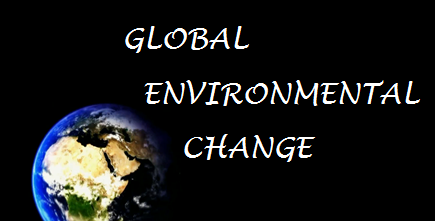Global Environmental Change
The human activities that are transforming the biosphere include land use changes, industrial development, energy production from fossil fuel and urbanization. The conversion of a forest to a grazing land or a cropland through deforestation causes loss of carbon stored in soil and vegetation to the atmosphere, and affects the global carbon cycle. Biomass burning associated with agricultural practices also releases CO2 in to the atmosphere leads to global environmental changes.

In recent times, due to domestic and industrial coal burning, huge amount of CO2 is being pumped into the atmosphere. Similarly, the concentration of gases like methane (CH2), nitrous oxide (N2O) and chlorofluorocarbons (CFCs) are increasing in the lower atmosphere. These gases (CO2,CH2,N2O and CFCs) are radioactively active gases (also called greenhouse gases) because they can absorb long wave inflamed radiation. The increased amounts of greenhouse gases in the atmosphere are affecting the global climate and this phenomenon is now recognized as Global Climatic Change Greenhouse Gases and Global Warming.
The atmospheric cover around the earth acts like a window glass pane. It allows most of the solar radiation to enter right up to the earth's surface, but does not allow a substantial amount of the long-wave radiation emitted by the earth to escape in space. The outgoing long wave infrared radiation is absorbed by the greenhouse gases normally present in the atmosphere. The atmosphere radiates part of this energy back to the earth. This downward flux of radiation, called greenhouse flux, keeps the earth warm. Thus, the atmospheric greenhouse gases forming a blanket over the earth control the escape of hot from the earth's surface to outer space so as to keep it warm and hospitable. The phenomenon is referred to as greenhouse effect. The name is derived from the fact that inside a glass enclosed greenhouse, temperature is warmer than outside. Such greenhouses are used for growing plants that require higher temperatures for growth.
The mean annual temperature of the earth is about 150C, however, in the absence of greenhouse gases in the atmosphere, the earths mean temperature would drop sharply to about -200C. This capacity of the atmosphere is keep the earth warm depends upon the concentration of greenhouse gases. The excessive increase in concentrations of these gases in the atmosphere would retain more and more of the infrared radiation, resulting in enhanced greenhouse effect. The consequent increase in the global mean temperature is referred to as global warming. The intergovernmental Panel on Climate Change (IPCC) periodically makes an assessment of the atmospheric abundance of greenhouse gases and its possible impact on climate and related issues.
Average Acceleration Calculator
Average acceleration is the object's change in speed for a specific given time period. ...
When an object falls into the ground due to planet's own gravitational force is known a...
In Mathematics, the permutation can be explained as the arrangement of objects in a particular order. It is an ordered...
A rectangle can be explained as a 4-sided quadrilateral which contains equal opposite sides. In a rectangle
A three sided polygon which has three vertices and three angles is called a triangle. Equilateral triangle...







